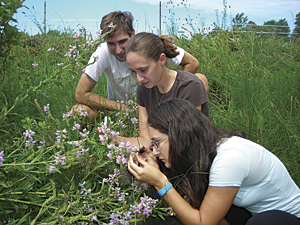A Role for Old-Fashioned Geographia in Education
"Geo Learning"
![]() A column by Daniel C. Edelson,
A column by Daniel C. Edelson,
Vice President for Education, National Geographic Society
 The word geography comes from the Greek geographia, which means "writing or describing the world." I frequently hear people say that the word geography is outdated because modern geography is about much more than just describing the world.
The word geography comes from the Greek geographia, which means "writing or describing the world." I frequently hear people say that the word geography is outdated because modern geography is about much more than just describing the world.
I tend to be sympathetic to that view because I believe that the power of modern geography is in its approaches to solving problems and answering questions. However, I think that describing the world is an essential component of geography, and it should have a central part in geography education.
I have been thinking about this a lot lately because I have been thinking about the challenges of teaching young people about human impacts on the environment. I have become convinced that the biggest challenge in teaching about the environment is students' lack of familiarity with their environment. How do you teach children about changes to the environment if they do not know what the environment is currently like?
But how, you might ask, is it possible to not be familiar with one's environment? In the modern world, there are two ways in which children are unfamiliar with their environment.
First, the environment they live in is increasingly circumscribed. Middle-class youth in our society live largely in enclosed, interior spaces. When they need to travel through external spaces, they tend to do so in enclosed vehicles that are piloted by an adult. Today's typical K–12 students go to school in a car or bus that picks them up very close to their homes and delivers them to the front door of their schools. They typically spend their afternoons in their school or another building, which they are transported to, again, in a bus or a car, until they return home by the same modes of transportation.
Second, they have little opportunity or motivation to notice their environments. They are isolated from the external environment by various forms of cocoon, and they are not responsible for navigating by themselves, protecting themselves, or caring for any aspect of the environment.
I do not want to romanticize the past, but I do want to point out that only two generations ago, most Americans still depended directly on their environment for their livelihood and were not isolated from the external world by fully climate-controlled, protective buildings and vehicles. I also cannot ignore the fact that most people on earth still live that way.
Middle-class American children no longer have much need to be aware of their environment. They are isolated and protected from it, particularly during the part of the day set aside for education.
The result is that we have created an excellent environment for young people to learn math, language arts, and abstract science and social studies, but we have created a terrible environment for young people to learn about their world. I worry about my own middle school daughter, who is studying earth science right now in a classroom that seals her off from any direct interaction with the natural processes that she is studying.
Worrying about how to teach children about a world from which they are so isolated eventually led me back to the original concept of geographia. Before students can understand the world, they need to observe it. To observe it, they need to experience it, of course, but they also need to notice it. It's not just about looking; it's about seeing. And teachers have known forever that the best way to get students to be good observers is to engage them in documentation and description.
At National Geographic, we have begun exploring ways to turn students into old-fashioned geographers—in other words, describers of their world. One of the strategies we have been using is engaging students in what different people call citizen science, public participation in research, and volunteered geographic information initiatives. In these projects, participants collect and share geographic information with each other and, in some cases, conduct investigations or solve problems with the information. At National Geographic, we've adopted our own term for these projects. We call them community geography projects, and with support from the National Science Foundation and Esri, we're developing a web-based GIS and social networking platform to support community geography initiatives.
I like to use Project BudBurst as an example of how these projects foster noticing. Project BudBurst is an educational outreach initiative of the National Ecological Observatory Network that focuses on phenology (seasonal changes) in plants. The concept behind BudBurst is very simple. You pick a specific tree or shrub and monitor it throughout the year, recording your observations in a database that is shared among thousands of people monitoring other trees and shrubs throughout the United States. You note when flower and leaf buds appear and open. You also note when they fade, turn color, and fall off.
It's safe to say that virtually every student in every classroom in America knows that plants have seasonal cycles. But how many of them know the specific cycle of any specific types of plants? And how many know how these cycles change from place to place and year to year? And how many know what the natural variability of those cycles is in a specific location or a specific year?
It is only when people are familiar with these kinds of patterns and cycles that they can begin to understand what it might mean for human activities to change the environment.
So, ironically, the key to achieving the understanding and problem solving that we associate with modern geography is to start with the observation, documentation, and description that are characteristics of traditional geography.
Information about National Geographic Education's Community Geography initiative is available at natgeoed.org/community-geography.
